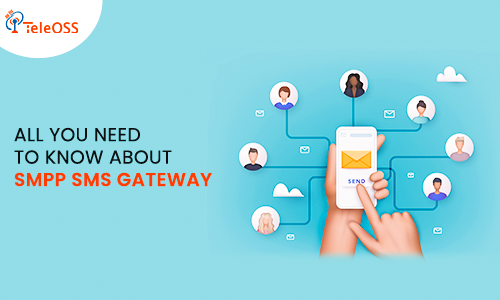In our fast-paced digital culture, now more than ever there is extreme demand for real-time and reliable messaging solutions. Whether an organization is sending a two-factor authentication (2FA) code, a marketing alert, or notifying a transaction, SMS is one of the most powerful means of communication. At the source of enterprise-grade SMS solutions, is the technology known as SMPP, the Short Message Peer-to-Peer protocol.
In this blog, we’ll break down everything you need to know about an SMPP SMS Gateway, including how it works, its benefits, use cases, and how to get started.
What is SMPP?
SMPP (Short Message Peer-to-Peer) is an open-industry standardized protocol that is being used throughout the telecom ecosystem by telecom operators, aggregators and bulk SMS providers to move SMS messages from Short Message Service Centers (SMSC) to External Short Messaging Entities (ESMEs), e.g. software applications or gateways.
SMPP is a superior protocol for high-volume SMS traffic than a basic implementation via something simple like an HTTP API, resulting in direct and high throughput connection to SMSCs, offering faster delivery times and stated resources, persistent sessions, better messaging options, efficient throughput handling, bi-directional communication, lower transmit time delays (latency), and better message routing and status control.
What is an SMPP SMS Gateway?
An SMPP SMS Gateway is a bridge between your application and SMSC platforms over the SMPP protocol. The gateway will allow you to send and receive extremely high volumes of SMS messages while maintaining low latency, high reliability, and secure connections. The gateway provides you with real-time delivery reports, delivery status updates, concatenated SMS, multiple encoding types, bulk messaging, and number masking.
This gateway is typically used by:
- SMS Aggregators
- Marketing Platforms
- Banking & Financial Services
- Healthcare Providers
- E-commerce Platforms
Key Features of SMPP SMS Gateway
- High Throughput: Send thousands of messages per second, ideal for enterprises and bulk campaigns. This ensures efficient delivery even during high-demand periods.
- Two-Way Messaging: Supports both outgoing and incoming messages for real-time engagement. Ideal for OTPs, customer feedback, and service confirmations.
- Real-Time Delivery Reports: Get instant updates on message status, including delivery success or failure. Helps in monitoring and optimizing your messaging performance.
- Unicode Support: You can message in any language including regional scripts like Hindi or Chinese. This is great for reaching all the diverse audiences across the globe.
- Low Latency: Delivers messages faster than HTTP or SMTP-based systems. Ideal for time-sensitive alerts and transactional messages.
- Session-Based Communication: Maintains a stable connection for consistent message flow. Reduces overhead and improves reliability for large-scale messaging.
Benefits of Using SMPP SMS Gateway
- Scalability: Perfect for applications requiring bulk SMS delivery with millions of users. Takes communications to scale as contact volume increases, without losing performance.
- Efficiency: Direct connection to SMSCs means fewer intermediaries and faster processing. This results in better throughput and reduced message delays.
- Reliability: Guarantees message delivery consistently and verification in real-time. Built for mission-critical communication, where message delivery and its accuracy truly matter.
- Cost-Effective: Reduces operational costs for high-volume users compared to per-message services. Offers better value with predictable, volume-based pricing.
SMPP for Global Messaging
When targeting international audiences, SMPP allows you to connect to multiple SMSCs across the globe, gaining further reach and reliability. SMPP also supports Unicode, which supports multiple languages, ensuring your campaigns are effective in all areas and languages.
SMPP vs HTTP API: Which One to Choose?
Whether you would use SMPP or an HTTP API for SMS delivery can often be contingent on your scale and technical requirements. In very high throughput scenarios, low latency situations and when real-time delivery feedback is necessary, SMPP would be your preferred choice. In those circumstances SMPP is ideal for larger messaging usage with large volume messaging operations such as telecommunication companies, banks and enterprises that are sending millions of messages each day. The complexity of using SMPP is much higher and you would not leverage the benefits of ease of installation and configuration.
HTTP APIs on the other hand, are much simpler to setup and connect with and are better suited for small to medium-sized applications. HTTP APIs enable moderate throughput and latency and limited delivery feedback but can be brilliant for startups or businesses that have smaller SMS volumes, limited technical resources, or for businesses that simply do not feel the need to install and configure SMPP.
Final Thoughts
SMPP SMS Gateway is an excellent choice for businesses wishing to enhance their messaging platform. Although it requires more technical understanding to set up than an HTTP API; it has outstanding efficiencies in performance – particularly for businesses sending bulk, time-critical messages.
Whether you are delivering direct mail, sending OTPs, or exchanging two-way conversations with customers, understanding how to use SMPP can make a difference in how your messaging strategy performs.
Boost your messaging performance with TeleOSS SMPP SMS Gateway trusted by enterprises for high-speed, reliable, and scalable SMS delivery. Get started today!


